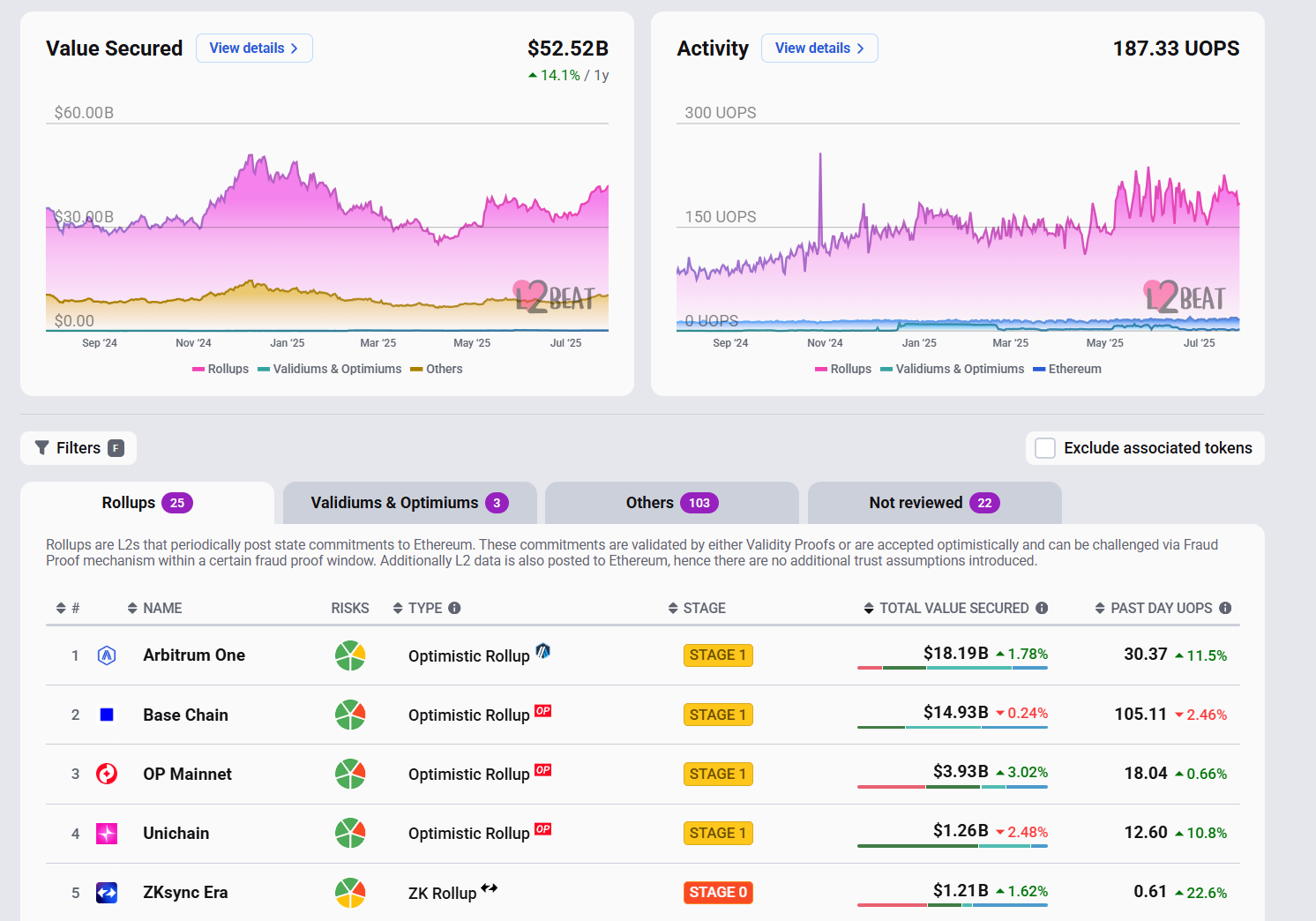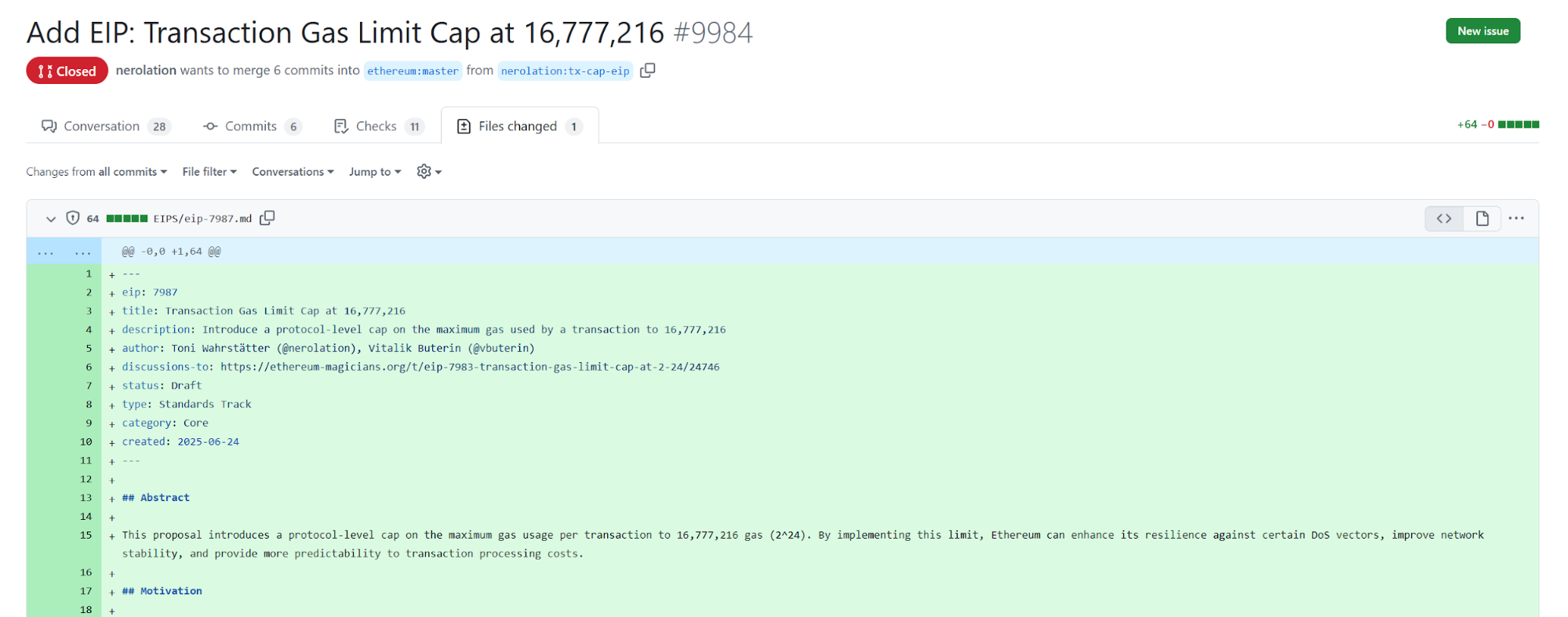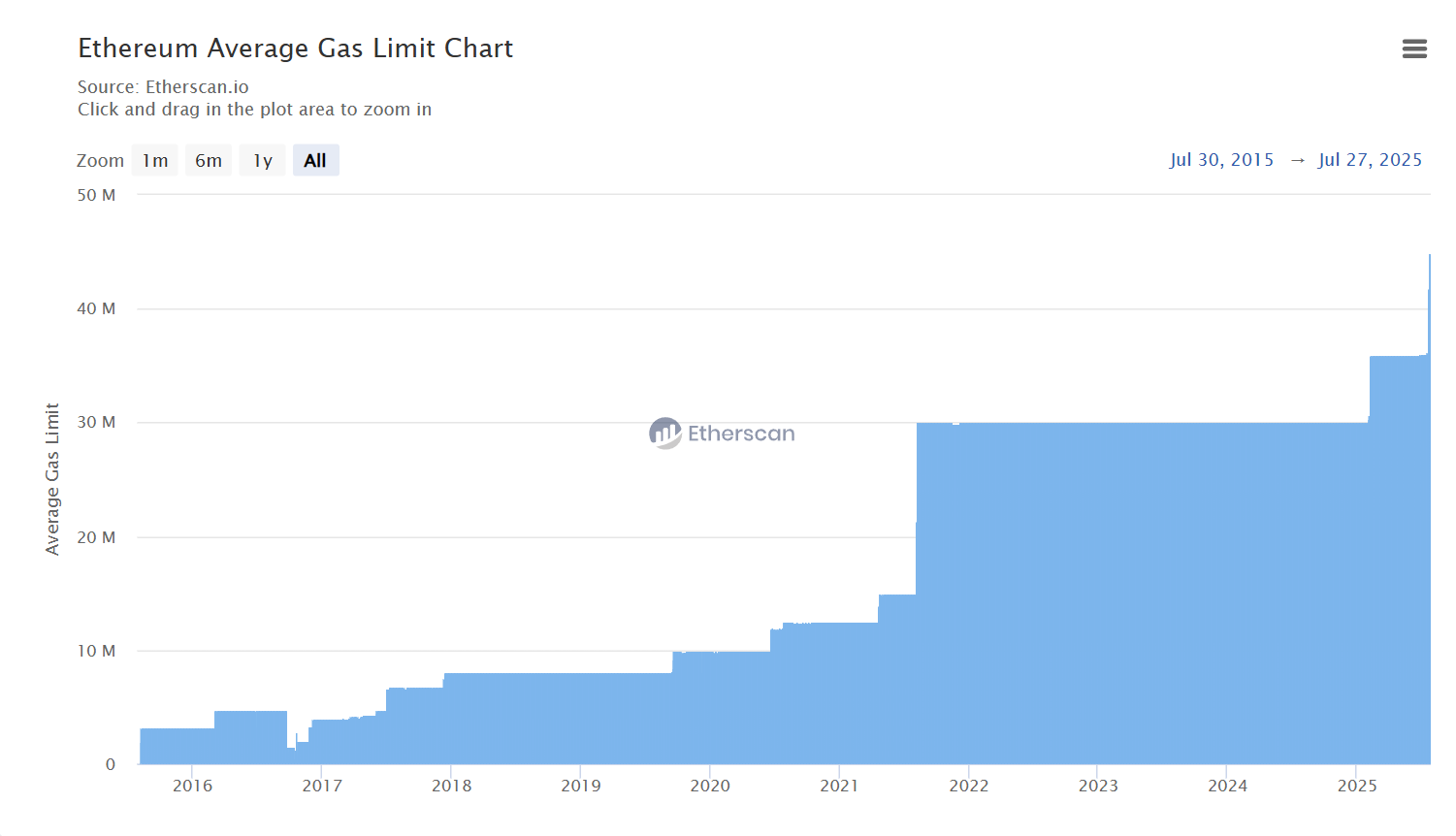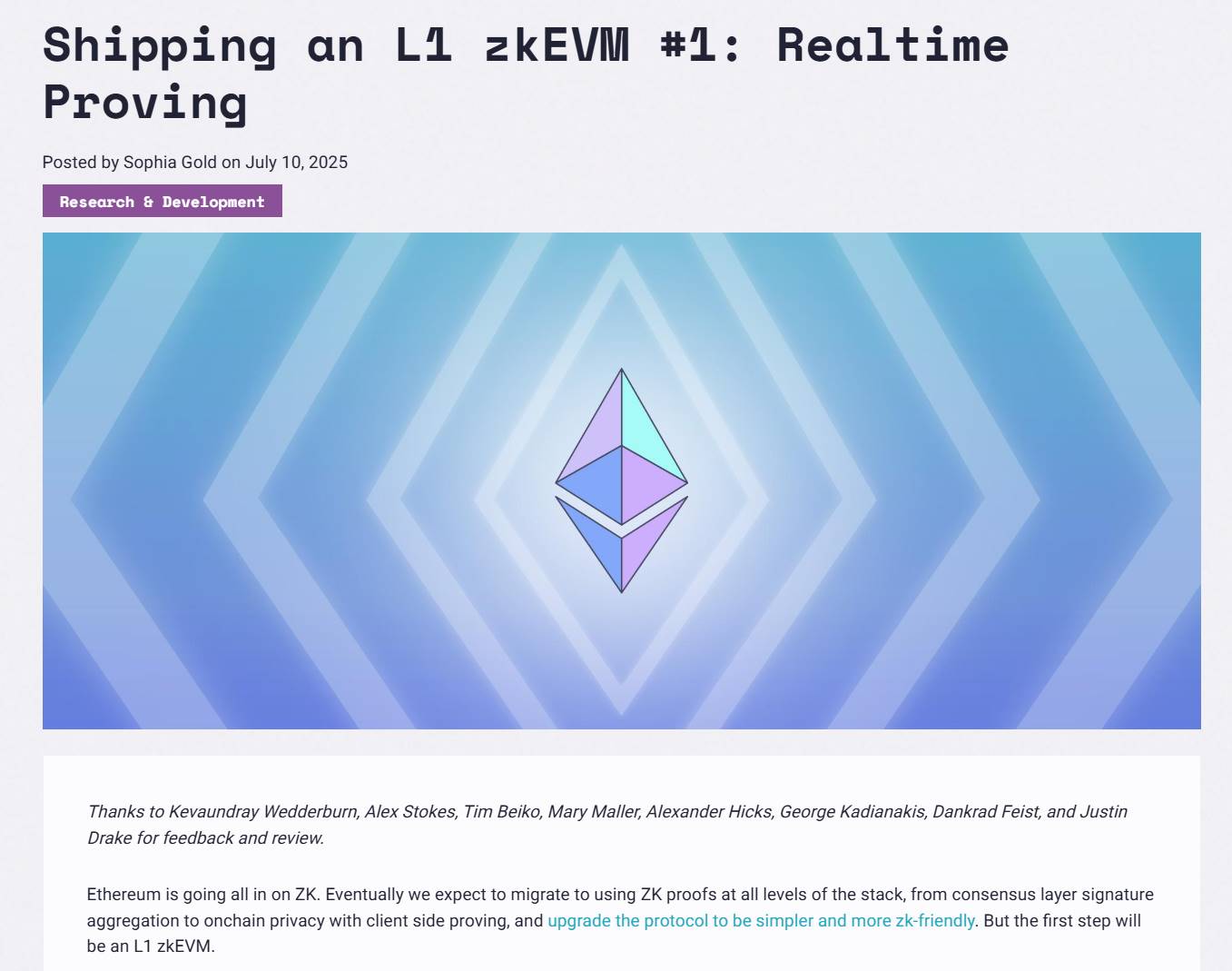From EIP-7987 to L1 zkEVM: Ethereum L1 Scaling and Advancement
What’s the single most important thing for Ethereum over the next five years?
L1 scalability.
This month, Vitalik Buterin and the Ethereum Foundation have both made major announcements on several key issues: from the EIP-7987 proposal (which the community initially called EIP-7983, now officially EIP-7987) seeking to cap single transaction gas usage, to L1 zkEVM officially entering its experimental phase, and to increasing the block gas limit. All these moves signal that Ethereum L1 scaling is accelerating toward real-world deployment.
In short, after L2 ecosystems hit important milestones, Ethereum is returning its focus to L1 scaling—rollups are already fast enough, but L1 can still become leaner, stronger, and more unified.
This article breaks down the technical updates behind these changes and explores how Ethereum L1 plans to deliver the next wave of large-scale growth.
I. Cyclical Integration and Separation: From L2 Back to L1
Since Vitalik Buterin published “A Rollup-Centric Roadmap” in 2020, rollups have become Ethereum’s go-to scaling strategy. This sparked the development of projects like Arbitrum and Optimism—effectively making L2s Ethereum’s new frontier.
However, rollups bring their own issues. As noted in Understanding ERC-7786: Is Ethereum Entering a Unified Era?, there are now more than a hundred L2s in the broad sense. This leads to fragmented transactions and value across L2s, and puts more weight on L1, which must handle data availability and final settlement.
That means L1 is under ever-increasing operational pressure. For example, high-gas transactions (like blob submissions and zkProof verifications) significantly increase L1 node computation and verification load. The bloated state space slows down node syncing and increases on-chain storage costs, while greater block packing time volatility creates security and censorship-resistance risks.

Source: L2Beat
In essence, L2’s growth over the last few years could be seen as “building walls”—each rollup tries to lock in users and assets within its own moat of liquidity. While this boosts siloed efficiency, it also chips away at Ethereum’s overall liquidity and network unity.
There’s an old saying: “What is united for long will split, what is split for long will unite.” Ethereum is at a turning point—moving from L2 fragmentation to L1 reintegration—which is, in some ways, a rebalancing after the L2-centric phase.
The goal: make the user experience across the network feel like one unified ecosystem, not a haphazard bundle of disconnected chains. Cross L1/L2 asset transfers, state sharing, and app switching should feel as seamless as on a single chain.
That’s why—from Based Rollups to ePBS to L1 zkEVM—the Ethereum Foundation’s protocol research team and developer community are pushing a series of L1-level upgrades. Their aim is to strengthen mainnet execution, usability, and resilience, without sacrificing security or decentralization.
II. EIP-7987 & zkEVM: Seeding Scalability Into Mainnet
The two biggest L1 scaling reforms in the spotlight are the EIP-7987 proposal and L1 zkEVM. Together, they represent critical upgrades in both resource allocation and the execution engine.
1. EIP-7987: Gas Cap Per Transaction to Ease Block Bottlenecks
The EIP-7987 proposal—co-authored this month by Vitalik Buterin and Toni Wahrstätter—recommends capping the gas usage for a single Ethereum transaction at 16.77 million. The core idea is to set a per-transaction gas ceiling (which is unrelated to the block’s overall gas limit).
On Ethereum, every transaction (whether a transfer or contract call) consumes some gas—and each block only has a fixed gas capacity. If one transaction spends too much gas, it can crowd out others for inclusion.

Source: Github
Some heavy-duty transactions (like zkProof verifications or large contract deployments) can use up most of a block in one go. The proposal aims to prevent these high-gas operations (such as zkProofs or massive contract deployments) from hogging block resources and causing node congestion—especially impacting parallel execution and light node syncing:
By enforcing a cap, any oversized transaction must be split, so no single transaction can monopolize resources. The restriction only kicks in during transaction execution—if a transaction exceeds the cap before inclusion in a block, it’s rejected during validation.
Besides single-transaction gas limits, block gas limit changes are underway too. On July 21, Vitalik Buterin tweeted, “Almost exactly 50% of stakers voted to raise the L1 gas limit to 45 million. The gas limit is now climbing and currently sits at 37.3 million.”
Theoretically, a higher block gas limit can directly boost Ethereum mainnet performance. Historically, though, Ethereum has taken a cautious approach, especially with L2 advances. In fact, after the gas limit was raised from 8 million to 10 million in September 2019, it took six years to reach 36 million today.
But this year, the Ethereum community’s stance has clearly become more “aggressive.” EIP-9698 even proposes a tenfold increase every two years—targeting a 3.6 billion gas limit by 2029, a 100x jump from today.

Source: Etherscan
This series of changes reflects Ethereum’s need to scale under pressure and sets the computational foundation for the upcoming L1 zkEVM execution upgrade.
2. L1 zkEVM: Zero-Knowledge Proofs Reshape Mainnet Execution
zkEVM is long seen as a potential “endgame” for Ethereum scaling. The main idea is to let mainnet verify ZK circuits, so every block’s execution can produce a zero-knowledge proof that other nodes can validate quickly.
Main benefits: nodes don’t have to re-execute every transaction—just verify the zkProof to confirm the block. This greatly reduces full node load, improves the experience for light clients and cross-chain verifiers, and sharpens security and tamper-resistance.
L1 zkEVM is moving rapidly toward reality. On the 10th of this month, the Ethereum Foundation released a real-time proofing standard for L1 zkEVM, as the first step toward integrating zk-proofs throughout the protocol. The mainnet will incrementally transition to an execution environment supporting zkEVM verification.
The public roadmap has Ethereum L1 zkEVM launching within a year, using compact zk-proofs to scale Ethereum securely, and gradually integrating zero-knowledge proofs throughout the protocol—a real-world test for Ethereum’s years of R&D.
This will turn the mainnet from just a settlement layer into a self-verifying execution platform—the so-called “verifiable world computer.”

In summary, if EIP-7987 fine-tunes execution efficiency at the micro level, L1 zkEVM is a macro-level breakthrough—potentially delivering 10x to 100x performance improvements and redefining Ethereum’s “value capture” capabilities.
L1 will move beyond a settlement layer to become a robust execution engine—serving as an access point for more users, assets, and liquidity, and putting Ethereum in a stronger position to compete with high-performance new chains like Solana and Monad.
And beyond just execution and transactions, Ethereum is also overhauling core resource management and governance mechanisms.
III. Other L1 Scaling Strategies
Besides EIP-7987 and zkEVM, Ethereum is rolling out mainnet scaling upgrades across protocol layers—building a high-performance, accessible, and fair on-chain execution environment.
The Ethereum Foundation is developing the ePBS architecture, aiming to fully separate proposer and builder roles. This will tackle MEV extraction and builder monopoly issues, improving fairness, censorship-resistance, and transparency in block production.
Crucially, ePBS is being deeply integrated with FOCIL—a module that enables light clients to validate blocks and execution results without maintaining full state online. Together, ePBS and FOCIL create a clear separation of powers across proposal, building, and validation, massively boosting network adaptability.
This combination could also support privacy transactions, light clients, and mobile wallets, lowering barriers and signaling Ethereum’s evolution toward a “modular consensus architecture” with stronger composability and governance flexibility.
Another overlooked but highly valuable scaling path is Stateless Ethereum, which aims to free nodes from relying on the entire network state. Instead, with a witness mechanism, nodes only download and verify data relevant to current transactions—dramatically reducing sync and validation costs.
The Ethereum Foundation is backing this with the bloatnet.info visualization tool, which quantifies the uneven burden of state bloat and supports future state-cleaning, compaction, and state rent models.
Additionally, the Ethereum research team has prioritized the Beam proposal—setting separate price curves for computation, storage, and calls, aiming to bring more nuanced resource pricing. This could shift Ethereum from a single-dimensional fee model to a multi-dimensional resource market, similar to resource scheduling in cloud computing.
Conclusion
Realistically, now that rollup scaling is mainstream and account abstraction is gaining momentum, many pin their hopes for scaling solely on the “off-chain execution + mainnet settlement” L2 model.
But the evolution of L1 continues—and remains irreplaceable.
L2s can absorb more users and free up execution space, while L1 provides unified settlement, a security anchor, and the foundation for resource governance. Only by having both evolve in sync can Ethereum form a truly sustainable, high-performance, global Web3 value network.
Ethereum’s future depends on L1 and L2 evolving together—only then can it become a true unified world computer..
Disclaimer:
- This article is a reprint from [TechFlow], copyright held by the original author [imToken]. For any concerns regarding this reprint, please contact the Gate Learn Team, and we will handle it promptly per our established procedures.
- Disclaimer: The opinions expressed in this article are those of the author alone and do not constitute investment advice.
- Other language versions of this article were translated by the Gate Learn Team. Without explicit mention of Gate, translated articles may not be copied, distributed, or plagiarized.





